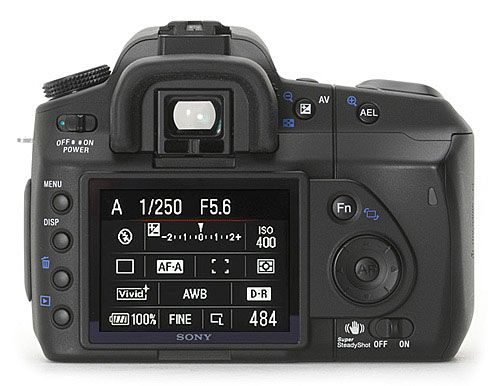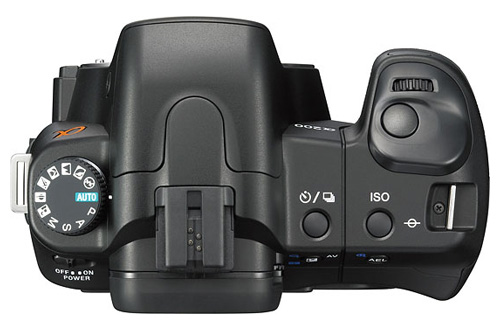Sony A200: Entry DSLR Roundup
by Wesley Fink on October 20, 2008 1:00 AM EST- Posted in
- Digital Camera
New Features, Improvements, and Omissions
The Sony A200 certainly epitomizes the fast pace of innovation in the DSLR market. When the Sony A100 was introduced it was the first of the 10MP DSLR cameras, and it was considered a breakthrough value at a price of just $999 with a kit lens. Now, just two years later the Sony A200 generally updates the A100 and cuts the price in half.
| Sony Camera Comparison | ||
| Sony A200 | Sony A100 | |
| LCD Screen | 2.7" Fixed | 2.5" Fixed |
| Sensor | 10.2 MP CCD | 10.2 MP CCD |
| AF Points | 9 | 9 |
| Sensor Size | 23.6x15.8mm | 23.6x15.8mm |
| Sensor Multiplier | 1.5x | 1.5x |
| Image Processor | BIONZ | BIONZ |
| Image Stabilization | Body Integral (All lenses) | Body Integral (All lenses) |
| Auto Sensor Clean | Yes | Yes |
| Live View | None | None |
| Metering Modes | Multi-Segment, CWt, Spot | Multi-Segment, CWt, Spot |
| ISO Range | 100-3200 | 100-1600 |
| Auto ISO Adjust | Yes | Yes |
| Continuous Speed | 3 fps | 3 fps |
| Wireless Flash Control with Built-in Flash | Yes | Yes |
| Remote Release | Wireless Remote, Cable | Wireless Remote, Cable |
| Storage | CF | CF |
| Viewfinder | .83x, 95% | .83x, 95% |
| Battery | NP-FM500H 1600mAh | NP-FM500H 1680mAh |
| Battery Life (50% Flash) | 750 | 730 |
| Battery Grip | VG-B30AM, Optional | No |
| Size | 131x98.5x71mm | 133x95x71mm |
| Weight (with Battery) | 1.39 lb. (626g) | 1.4 lb. (638g) |
| Kit Lens | 18-70mm f3.5-5.6 (28-105mm) | 18-70mm f3.5-5.6 (28-105mm) |
| Price with Kit Lens | $499 | $999 |
Normally a 50% price cut on a new model means reducing features. However, the A200 generally retains the same features as the well-regarded A100 while improving the camera in several areas. The LCD is now 2.7", up from 2.5" in the A100. While the sensor is the same resolution as the A100, the 10.2MP sensor now supports ISO 3200, up from the ISO1600 max of the A100. High ISO noise reduction is now adjustable on the A200.



Sony adds a 16:9 HDTV shooting mode to the A200, and image quality adjustments - contrast, saturation, sharpness - have wider adjustment ranges on the A200 than the A100. Super Steady Shot is also said to be improved on the A200. The only major omission sacrificed to the price reduction appears to be the depth-of-field preview button now absent on the A200.

The Sony A100 was criticized by many for not offering a battery grip option for extended battery life and better portrait handling. The A200 corrects that by supporting the Sony VG-B30AM battery grip that is also compatible with the Sony A300 and A350.
Sony has also continued some features you certainly don't expect to find in an entry-level DSLR. Most significant of these is the continued support for Wireless Flash capabilities that can be controlled by the built-in flash on the A200. Another is the 9-point AF module, which stands out in a class where some competitors try to get by with 3-point AF. The Sony A200 also continues real spot metering and adjustable bracketing, which are features some competitors have dropped to differentiate their higher-cost models.










32 Comments
View All Comments
Wesley Fink - Tuesday, October 21, 2008 - link
Those coming from P&S who insist on Live View would probably be happiest with the Sony A300 ($599 kit) or A350 ($799). If they want a fast-focusing capable traditional DSLR the A200 has a fast 9-point module that works well with off-center targets, tracks moving subjects well in sports and kid shooting, and is one of the fastest AF and largest brightest viewfinders in its class.When the new Panasonic G1 micro 4/3 hits the shelves it features a sensor with truly fast contrast-detect AF that many users will find very satisfying in Live View mode. It is the first contrast Live View we have seen that is likely to satisfy DSLR fans. It is likely the first of a new generation of fast Live View sensors that will be used in future competing DSLR cameras.
Heidfirst - Tuesday, October 21, 2008 - link
the wireless flash controller will also work with Sigma, Vivitar etc. flash guns too so you can certainly get down to at least 1/2 the price of a 42AM. I agree that it's probably a function not used y the majority of A200 users but some people who may might use the A200 as a 2nd/backup body to e.g. an A700.The A200 doesn't have live view & other than the A300/A350 with their particular & unusual implementation autofocus in live view is pretty poor (slow) on DSLRs. At any rate A200 autofocus is as good as (or better than) any other DSLR in it's price bracket.
remember that most p+s use contrast detect AF whereas DSLRs use phase detect (other than in live view except A300/A350).
computerfarmer - Monday, October 20, 2008 - link
I have noticed the Sony a200 review on dpreview dated July 2008 with an announcement date of January 2008. you can view it here.http://www.dpreview.com/reviews/specs/Sony/">http://www.dpreview.com/reviews/specs/Sony/
Perhaps there are changes I am unaware of.
This does appear to be a nice camera for the money. It has a good size sensor along with a decent kit lens.
Is it true the future is in cmos sensors?
What is the expected life span of CCD/CMOS sensors?
Wesley Fink - Monday, October 20, 2008 - link
CMOS sensors are cheaper to manufacture and it is much easier to integrate associated electronics into a CMOS sensor.It is worth mentioning, however, that the newest highest-res mid-size Kodak sensor, used in the new Leica Medium Format camera, is a CCD sensor, and some still claim the CCD to be superior in image quality.
For a more in-depth discussion of CCD vs. CMOS you may want to look back at our Digital Sensor Articles with Part 1 at http://www.anandtech.com/digitalcameras/showdoc.as...">http://www.anandtech.com/digitalcameras/showdoc.as... and part 2 at http://www.anandtech.com/digitalcameras/showdoc.as...">http://www.anandtech.com/digitalcameras/showdoc.as....
computerfarmer - Tuesday, October 21, 2008 - link
Thank you for your prompt reply.I took the time to read both the articles. They help in understanding the differences between CMOS/CCD sensors. Yet everything electronic has an expected lifespan. Does anyone have an expected lifespan for these sensors?
Hulk - Monday, October 20, 2008 - link
Looks to me like the lenses you are using are scratching the limits of the sensors, thus the results are all pretty much the same. Using a prime at f/8 will pretty much take the glass out of the comparison as most any prime is quite sharp at f/8 unless there is something wrong with it.Also please test using a subject with more colors so we can see how each camera handles demosiacing under increasing ISO.
Thanks for you hard work.
- Mark
Wesley Fink - Monday, October 20, 2008 - link
As stated on the test pages all the test shots used a 50mm f1.4 prime stopped down to f/4.0. We are down 3 stops from the rated speed and in all cases the glass is in its highest resolution range.The only exception to this is the Olympus tests, where we use a 35mm prime macro lens stopped down to f4, which has been tested to be in the highest resolution area of that lens.
This is because of the 2x factor on Olympus which gives us a 70mm equivalent. That is much closer to the 75- 80mm equivalent of the 50mm on the 1.5X-1.6X sensors. The 50mm macro on the Olympus would be equivalent to 100mm.
Test results are closer because other manufacturers have made dramatic improvements in their sensors in the last couple of years. Canon no longer enjoys the massive lead in sensor resolution and low noise they enjoyed with their CMOS sensors in the early years of DSLR technology. As pointed out in the test comments, many of today's competing cameras in the entry category use the Sony 10.2 megapixel sensor so results would be similar.
The biggest differences are detailed on page 9 in the comparisons of the 3 Sony sensors used in the A200, A350, and A700. The new 24.6 megapixel A900 could have been included as we have one in house, but it seemed a stretch to include a $3000 camera with resolution more than twice the entry-level DSLRs.
As Jarred has pointed out we always use the kit lens for sample images that are normally included in our reviews, so photos will be representative of what a normal buyer might expect. We similarly always use primes stopped down to the same f/4 for our noise and resolution tests to remove glass variations from the equation.
Hulk - Thursday, October 23, 2008 - link
The reasoning to use primes is NOT to test lenses but to try to eliminate lenses as a variable during testing and atually see how the bodies perform. By using less than very good lenses it's hard to tell what is limiting performance, the lens or the body.Since you are not testing scenes with any depth of field just use the sharpest setting, which is f/8 for just about any lens. f/4 would be applicable to test bokeh for a depth of field shot.
Again I know it's easy to complain. But really I'll I'm saying is use primes and stop down to f/8 so we can isolate the camera body performance.
Thanks,
- Mark
strikeback03 - Thursday, October 23, 2008 - link
According to photozone.de, the center resolution of the 50 1.4 is essentially constant from f/2.8-f/5.6, and down a bit at f/8 (corners top out at f/5.6).http://www.photozone.de/canon-eos/159-canon-ef-50m...">http://www.photozone.de/canon-eos/159-c...mm-f14-u...
slrgear calls f/4 and f/5.6 essentially tied, with f/8 a little worse.
http://www.slrgear.com/reviews/showproduct.php/pro...">http://www.slrgear.com/reviews/showproduct.php/pro...
Both of these tests are on an 8MP sensor, and the center resolution numbers are pushing the boundary of that sensor, so larger differences might be revealed in tests with a higher resolution sensor. For the 10MP sensors though f/4 would seem to be a very valid choice.
melgross - Thursday, October 23, 2008 - link
You know that 50 1.4's are not very good, even stopped down a couple of stops.I would choose the Olympus 35mm macro for quality over the 50's. Try a 50 or 60mm macro instead. It's about as close as you're going to get to the 35mm macro in quality to even out the lens issue.